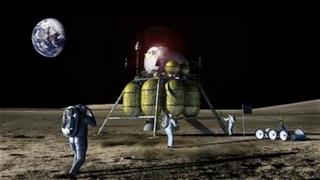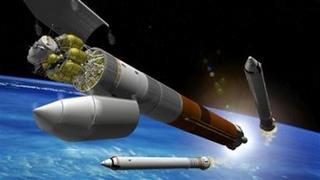
Back To The Future, Here We Come
We're talking the moon here. I saw the news bullwtin in the plane as I was heading back from NZ. NASA is planning to return to the moon with a manned mission by 2020. The pricetag? 135 Billion. Naturally critics are grumbling.
Some pundits took a stance similar to those at The New York Times, who saluted NASA’s “Apollo on steroids” approach in an editorial but also noted: “Unfortunately, the new plan lacks the pizzazz to inspire public support and will be operating under budget constraints that make delays or overruns likely.”
NASA’s roadmap to the moon, Mars and beyond also prompted House Science Committee Chairman Sherwood Boehlert, a Republican from New York, to applaud the exploration architecture while underscoring budgetary concerns.
Boehlert congratulated Griffin and his team on the “very thorough work” they have done. “While we are still reviewing the details, it appears that NASA has come up with an effective way to move forward, making the most of past U.S. investments in human space travel to enable us to enter the next phase of exploration in the safest, least expensive and most efficient way.”
That being said, Boehlert added: “The question Congress and the administration will still have to grapple with most is not the nature or desirability of the exploration architecture, but rather its timing.”
The lawmaker cited funding shortfalls in the space shuttle program, explaining that there is simply “no credible way” to accelerate the development of the shuttle follow-on — the Crew Exploration Vehicle — unless the NASA budget increases more than has been anticipated.
“Whether such an increase is a good idea in the context of overall federal spending at this time is something neither Congress nor the administration has yet determined,” he said in a written statement.
It's unappealing because in people's minds, the moon is a place where we've been and gone. People are looking to Mars. At the same time it should be noted that what NASA is talking about is talking about is developing a heavy lift vehicle that will take on future missions to Mars, let alone the moon. There's alos a Zurbin quote heere that's notable:
Zubrin also said there is negative aspect to the heavy-lift launch vehicle decision.
While preserving the heavy-lifter infrastructure, the plan relegates its development to a subsequent administration. “In consequence, for the next 13 years, NASA will continue to send crew after crew up and down to low Earth orbit, at a cost of some $70 billion, for no justifiable purpose whatsoever.”
In the post-Columbia environment, Griffin and others “have made the point that if we are to accept the costs and risks of human spaceflight, we should be undertaking missions that are worthy of those costs and risks,” Zubrin explained. “But for the next 13 years, we will continue not do so.”
So it might be the case that they get to the moon much later than the scheduled 2018/"by 2020".
Paul Spudis, a lunar and planetary scientist at the Applied Physics Laboratory, a research and development arm of the Johns Hopkins University in Laurel, Maryland, takes issue with those that see the NASA vision as an Apollo replay.
There is significant difference in Apollo of yesteryear judged against the NASA plan of today, Spudis said.
In the first place, the systems making up the vehicles are being designed for maximum leverage: long-life, cryogenic-based propulsion, potential reuse in space, Spudis explained.
Secondly, the mission is different.
“In Apollo, the mission was to prove we could land on the Moon and return safely to Earth. In this case, the mission is to determine the best site to collect and use the resources of the Moon and to emplace the necessary infrastructure to do so,” Spudis said. “Admittedly, the early missions will be very much like a ‘super-Apollo.’ However, they have potential to grow into something very different.”
Exactly what kind of 'different' he didn't say.


No comments:
Post a Comment